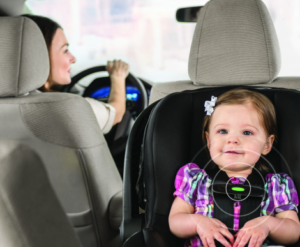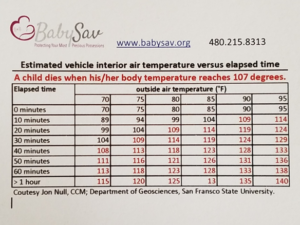Why Can’t We Save Lives?
Why Can’t We Save Lives?

We hear way too often, especially in the summer months, of children and pets dying in unattended cars due to a caregiver forgetting them. On the average, 39 children die each year in the United States due to this scenarioi. Additionally, an unknown number of pets succumb to this problem each year as well. The problem is not biased to any gender, demographic or region of the world. We also hear and read about 1000’s of situations where a child or pet were locked in a car where emergency personnel or locksmith had to be called to help unlock that car.
So with all of these occurrences what CAN and IS being done to help end this problem,
or is there a solution?

As shown above, there are many MAJOR areas being focused on;
Legislation, Technology, Education and Awareness
So with this all these efforts, why do we continue to loose lives each year?
One of the main reasons is that many caregivers (Parent, Grandparent, Siblings, Babysitters, etc.) feel
that:
 “This will Never Happen to Me” as they are
“This will Never Happen to Me” as they are
“Loving and Caring Caregivers”ii
But as the data shows each year it does. In fact more than 60% of these cases are due to a distracted or forgetful caregiver.
With the premise, if a caregiver does not believe this situation will or can occur to them or anyone within that child or pets support circle, then all the solutions made available will or may not be used, or if they are, they may not be used consistently. In fact it was reported by the National Highway Safety Administration that some of the products evaluated required more user interaction than others. Some required user actions that, if not completed, would lead to the system not functioning properlyiii.
As shown below each of the solutions identified require that the caregiver monitors, takes actions, and is consistent in their day to day actions. Again, it is not just the parent; it is anyone that is responsible for that child or pet at that time.
These solutions range from new technologies being developed into newer cars and car seats, in addition to phone APPS and aftermarket technological solutions. Recently, the US Legislation is voting on requiring all new vehicles to be equipped with such solutionsiv. These solutions are that of reminders. As other solutions in the past (i.e.: seatbelts), it will take many years before all caregivers within the child’s life has such a vehicle or technological solution.
 Other solutions that are constantly discussed, in the media, is to place an item in your back seat; such as a shoe, pocketbook, cell phone, etc. so that when you go to retrieve them you will see your child. As with any solution consistency is KEY! The one time you forget to follow these ideas or tips may be the last time you will see your child.
Other solutions that are constantly discussed, in the media, is to place an item in your back seat; such as a shoe, pocketbook, cell phone, etc. so that when you go to retrieve them you will see your child. As with any solution consistency is KEY! The one time you forget to follow these ideas or tips may be the last time you will see your child.
 There are also solutions where many states have enacted a Good Samaritan Law. This is where a passer-byer can take actions to break into a vehicle where a child or pet may have been forgottenv. There are stipulations to the law, so that no legal action can or will be taken against the Good Samaritan. This does require someone to notice a situation before it is too late.
There are also solutions where many states have enacted a Good Samaritan Law. This is where a passer-byer can take actions to break into a vehicle where a child or pet may have been forgottenv. There are stipulations to the law, so that no legal action can or will be taken against the Good Samaritan. This does require someone to notice a situation before it is too late.
Based on the outside temperature it may only take minutes before a child or pets life is taken in these situations as shown.
 Another approach is to grab the caregiver’s attention once they have left the vehicle in hopes that they will return back to the child or pet that they forgot, within the first few secondsvi. This solution does not require any maintenance by a caregiver and can be placed in many locations within a home or business.
Another approach is to grab the caregiver’s attention once they have left the vehicle in hopes that they will return back to the child or pet that they forgot, within the first few secondsvi. This solution does not require any maintenance by a caregiver and can be placed in many locations within a home or business.
Yet, as with all current solutions they still need to be observed by the caregiver for them to take action.
Today, all of these solutions are needed as explained, as not one of them is a 100% guarantee that they will stop a caregiver from forgetting.
What is common to all of these solutions is that are trying to solve the one problem: Caregivers Forgetting.
So why do caregivers forget and is it a real problem?
Per Gene Brewer, an ASU associate professor of psychology who has testified as an expert witness in a court case involving a parent whose child died in a hot carvii.
“Often these stories involve a distracted parent,” he said. “Memory failures are remarkably powerful, and they happen to everyone. There is no difference between gender, class, personality, race or other traits. Functionally, there isn’t much of a difference between forgetting your keys and forgetting your child in the car.” Most people spend a lot of time on routine behaviors, doing the same activities over and over without thinking about them. For example, driving the same route to work, taking the children to day care on Tuesdays and Thursdays, or leaving car keys in the same spot every day. When new information comes into those routines, such as a parent’s day care drop-off day suddenly changing or an emergency phone call from a boss on the way to work, that’s when memory failures can occur.
“These cognitive failures have nothing to do with the child,” Brewer said. “The cognitive failure happens because someone’s mind has gone to a new place, and their routine has been disrupted. They are suddenly thinking about new things, and that leads to forgetfulness. Nobody in this world has an infallible memory.”
There are many other similar reports viii ix that demonstrates that this problem is real and we need a TOTAL solution that will help save the lives of the child or pet that has no idea of what is about to happen.
BabySav is currently working on such a solution that will address the above gaps in solutions today:
- Will not require the caregivers intervention
- Will not require the caregiver to purchase any solution
- Will ensure that when a caregiver does forget or is distracted that a life is not lost
There is NO reason we should lose another child or pet due to our busy lives or distractions. These children are the future and need to have the opportunity to demonstrate
what they can bring to this world.
i Jan Null, CCM, Department of Meteorology and Climate Science, San Jose State University: https://noheatstroke.org
ii Kids and Cars: https://www.kidsandcars.org/how-kids-get-hurt/heat-stroke
iii US Department of Transportation, National Highway Safety Administration in a July 2015 report: Functional Assessment of Unattended Child Reminder Systems
iv Congress.gov: https://www.congress.gov/bill/115th-congress/house-bill/2801, June 2017
v Very Well Health: https://www.verywell.com/do-all-states-have-good-samaritan-laws-1298836, Sept 2016
vi BabySav: www.babysav.org
viii HUFF Post: https://www.huffingtonpost.com/2010/04/13/gene-weingartens-pulitzer_n_535752.html. May 2011
ix NBC News: https://www.nbcnews.com/storyline/hot-cars-and-kids/hot-car-deaths-scientists-detail-why-parents-forget-their-children-n777076, June 2017

